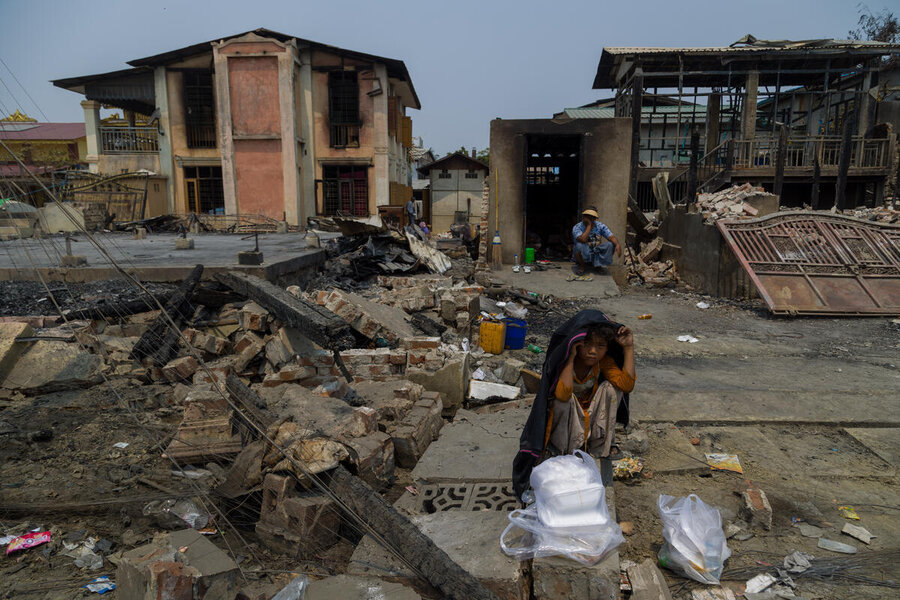Myanmar earthquake: WFP delivers assistance to hardest-hit areas

Donate to help WFP save lives in Myanmar
In the immediate aftermath of Myanmar's earthquake, which has claimed more than 3,000 lives, WFP assisted 24,000 people in the hardest-hit areas of Mandalay, Nay Pyi Taw, Sagaing and Shan, using emergency food stocks.
Over 200 metric tons of fortified biscuits are available for immediate distribution, with an additional 7,000 metric tons of food within Myanmar to assist communities that suffered the highest levels of damage.
WFP aims to reach 100,000 people with ready-to-eat food in the first phase of response, followed by food assistance for 850,000 people for one month.
Distributions of emergency food assistance started in Nay Pyi Taw within 48 hours of the earthquake on Friday 28 March, and have since expanded into Sagaing, Shan and Mandalay – part of Myanmar’s Dry Zone, where longstanding armed conflict continues to rage.
“This is an area that was already suffering from chronic poverty, ongoing conflict and frequent displacement,” said Melissa Hein, WFP’s head of partnership and communication for Myanmar. “In fact, a majority of displacement over the past four years has been in Sagaing, where more than 1.2 million people were already displaced.”

In Sein Pan, one of the worst-affected wards in Mandalay, WFP teams found most homes destroyed, “either by the earthquake or a major fire that followed in that area, so people are anxious and afraid.”
Hein added: “Even if buildings are standing, many don’t want to return home for fear of collapse. Aftershocks are still a regular occurrence.”
Looming hunger
According to the UN, 20 million people need humanitarian support across the country, with 15 million facing food insecurity and a total of more than 3.5 million people displaced by conflict.
WFP’s initial assessments showed food insecurity was already prevalent in the earthquake-affected areas: 5.8 million acutely food-insecure people live in the impacted regions, including 1 million already facing emergency levels of hunger.
The impact of the earthquake will push those vulnerable families further into the depths of hunger and malnutrition. In March, WFP had to cut food assistance to 1 million people, reducing our emergency footprint in the country to 35,000 people.
“Those cuts were in response to the existing funding gap,” said Hein. “And those gaps remain,” while “humanitarian needs are even bigger.”
Michael Dunford, WFP’s Country Director for Myanmar, warned this shortfall could not persist.

“Without funding, we cannot do what we need to do – we cannot meet the needs of the people,” he said. Speaking to UN News, he added: “Buildings are down, infrastructure is disrupted,” and at food-distribution points, “you meet the people who have been impacted, and you hear their stories … it is devastating.”
Access to earthquake-hit areas and unreliable telecommunications continue to pose challenges for humanitarian organizations trying to scale up.
“It is really a holistic effort,” said Dunford, adding that WFP is working with UNICEF (UN Children’s Fund), UNHCR (Office of the UN High Commissioner for Refugees), WHO (World Health Organization), and OCHA (Office for the Coordination of Humanitarian Affairs). WFP is coordinating with humanitarian partners to set up an emergency logistics hub and emergency communications in order to launch a comprehensive life-saving response.

In line with the UN’s principles of humanity, neutrality, impartiality and independence, Dunford called for unhindered humanitarian access “during this period when we all need to be able to respond.”
“We need to be able to reach affected populations, conduct assessments and launch our response quickly,” he said. On Monday 31 March, Dunford met survivors of a mosque collapse.
“Many people lost loved ones, and WFP was providing basic support to those who had lost their breadwinners,” he said. “Awful stories to hear, and it really speaks to the need for the international community to respond - and respond quickly - and for donors to respond generously.”

People in their own words
In Pyinmana, near Nay Pyi Taw, a resident told WFP: “There are 15 of us … all living under the same roof – what’s left of it. We can’t afford to rebuild. Four of our family members work as casual labourers when there’s work, but now everything has stopped.
“In our community, at least 23 people died and many others were injured. Now, most families are sleeping on the street. The earthquake is over but it left us with nothing. No income, no way to start over. The money we have will last only three more days.”
A woman in her late seventies said: “I used to sell bottled water in the market – that’s how I survived. I earned 3,000 kyats (US$ 0.72) a day. Now, all we have left is uncertainty. The shaking has stopped, but the fear remains.”
WFP is working to secure the additional resources it needs to scale up the response in Myanmar.

